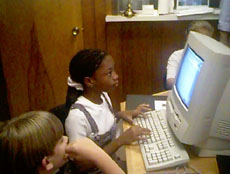|
July 15, 1997
The Shodor IEC students, returning to the Foundation for the second day of their IEC experience, were given a formal introduction into how web browsers function. The students were also introduced to the idea that information posted on the Internet, no matter how credible it may seem, should not be taken at its face value. To explain this principle, the Foundation elaborated on the idea that the Internet is full of information that disagrees with seemingly equally credible sites, and that none of these sites should be simply taken as fact. The day began with a review of the previous day by principle instructor Joe South. Joe, concentrating on yesterday's information highlighted what the students' had already learned about the Internet and e-mail. This introduction eventually broke off into a fairly interesting philosophical tangent regarding machines and their makers. "Can a machine be smarter than the person who makes it?" was the question students directed towards their instructor. Joe South was forced to confess that he did not have all the answers to these difficult questions, but reiterated that this was also not the purpose of the IEC program. "These are all good questions," explained Joe as he attempted to prepare the students for the day's directives, "but they need to be discussed elsewhere." Following this deep and rather provocative discussion, Anne Thissen, a Shodor intern, introduced the students to the idea of credibility in the Internet. "What if I told you that there was a flood in Chicago yesterday?," queried Anne adding, "would you believe it?" The students, faced with this question, were forced to consider what would make good determination factors for a site's credibility. In so doing, they determined that a site's reputation was a major factor. Relying on the credibility of "big-names" and up-to-date information, the students devised the issues that a site had to reconcile before becoming credible. In addition, the students highlighted the need to consider a site's internal consistency and whether or not sites had noted their sources. Once the students had determined credibility factors, they were directed onto the Internet for an exercise in credibility. Searching periodical tables already bookmarked by the Foundation, students were assigned one or two sites to evaluate. Although looking for the highest element on the periodical tables, students were also asked to remember the site's source and evaluate its credibility. The results were definitely interesting. Students had determined that the answers were terribly inconsistent, despite the fact that the sources were often major universities like MIT. To explain this difference, Anne brought up the real truth in the matter: new elements are constantly being discovered, and at this level of science the results are often debatable. Hence, all the sites were right in some sense, despite the fact that they may disagree with one another. Because of this, it is the person searching the Internet who must determine whether or not information is reliable.
Next, Monte Evans provided the students with a quick understanding of how to bookmark sites. Monte, Shodor's second youngest intern, showed the students how to create and organize bookmarks before exporting these bookmarks to a 3.5 inch diskette. Following this presentation another of Shodor's interns, Alton Patrick, introduced the students too search engines. Beginning with Yahoo!, the students were asked to follow a categorical listing in order to find information on the Hubbell Space Telescope. The students mastered this quickly, and as a result Alton had them 'race' for a picture of a whale using this categorical method. With the categorical search quickly mastered, the students were able to investigate AltaVista. Using AltaVista, the students were given a proper understanding of traditional search syntax. Of interest to the students was the investigation of 'bats.' Alton walked the students through the exercise, highlighting the difference between athletic equipment and live animals. Because the student's wanted information on the animals, the abundance of information on baseball bats would be distracting. However, when the students removed 'baseball' from the search they still received a #1 match from Louisville Slugger! Even the reliability of search engines have to give way to the inaccuracy of the site itself. The students completed the day looking up five sites on a scientific topic of their choice. Bookmarking these sites and placing them in a folder they had created, the students attempted to use their new knowledge to find reliable science sites on the Internet. The day, now completed, was certainly not wasted. Students left the Foundation with a vast knowledge of how to properly search and bookmark sites on the Internet for later use. In addition, the students also maintained an intuitive knowledge about the reliability of such sites on the Internet. Now, armed with the knowledge of how to determine a site's credibility, as well as the knowledge of how to find and list these sites, the IEC students are ready to further their knowledge of science and the Internet over the next three days.
Last Update: June 14, 1999 Please direct questions and comments about this page to WebMaster@shodor.org © Copyright 1998 The Shodor Education Foundation, Inc. |



